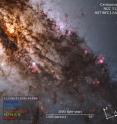Firestorm of star birth in the active galaxy Centaurus A
Resembling looming rain clouds on a stormy day, dark lanes of dust crisscross the giant elliptical galaxy Centaurus A. Hubble's panchromatic vision, stretching from ultraviolet through near-infrared wavelengths, reveals the vibrant glow of young, blue star clusters and a glimpse into regions normally obscured by the dust.
The warped shape of Centaurus A's disk of gas and dust is evidence for a past collision and merger with another galaxy. The resulting shockwaves cause hydrogen gas clouds to compress, triggering a firestorm of new star formation. These are visible in the red patches in this Hubble close-up.
At a distance of just over 11 million light-years, Centaurus A contains the closest active galactic nucleus to Earth. The center is home for a supermassive black hole that ejects jets of high-speed gas into space, but neither the supermassive or the jets are visible in this image.
This image was taken in July 2010 with Hubble's Wide Field Camera 3.
Source: NASA/Goddard Space Flight Center
Articles on the same topic
- Spectacular Hubble view of Centaurus AThu, 16 Jun 2011, 14:34:47 UTC
Other sources
- Dusty Nearby Galaxy Blazes Bright in Hubble Photofrom Space.comFri, 17 Jun 2011, 13:01:39 UTC
- Firestorm of Star Birth in the Active Galaxy Centaurus Afrom Newswise - ScinewsFri, 17 Jun 2011, 1:30:29 UTC
- Hubble photograph of Centaurus A reveals bright jewel behind dustfrom The Guardian - ScienceThu, 16 Jun 2011, 16:31:03 UTC
- Spectacular Hubble view of Centaurus Afrom Science DailyThu, 16 Jun 2011, 14:30:24 UTC
- Firestorm of Star Birth in the Active Galaxy Centaurus Afrom Newswise - ScinewsThu, 16 Jun 2011, 13:30:17 UTC
- Spectacular Hubble View of Centaurus Afrom PhysorgThu, 16 Jun 2011, 13:20:12 UTC
